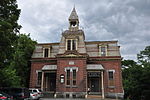Wells River (Vermont)
Bodies of water of Caledonia County, VermontNortheastern United States river stubsRivers of Orange County, VermontRivers of VermontTributaries of the Connecticut River ... and 1 more
Vermont geography stubs
The Wells River is a tributary of the Connecticut River, approximately 15 miles (24 km) long, in the U.S. state of Vermont. The Wells River begins at the outlet of Ricker Pond at the southern boundary of Groton State Forest in the town of Groton. The river flows generally southeast through the towns of Ryegate and Newbury, reaching the Connecticut River at the village of Wells River. U.S. Route 302 follows the river for most of its length.
Excerpt from the Wikipedia article Wells River (Vermont) (License: CC BY-SA 3.0, Authors).Wells River (Vermont)
Mill Street,
Geographical coordinates (GPS) Address Nearby Places Show on map
Geographical coordinates (GPS)
| Latitude | Longitude |
|---|---|
| N 44.1542302 ° | E -72.0470357 ° |
Address
Mill Street 2
05081
Vermont, United States
Open on Google Maps








